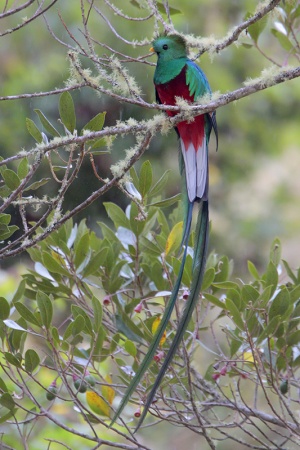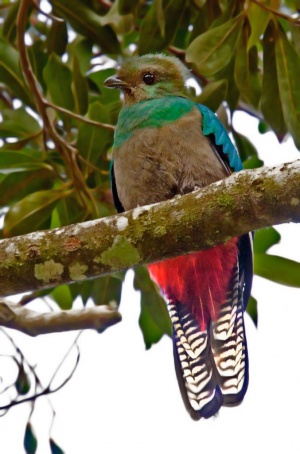(Picture of female. Basic tidy-up. Some more copied text disguised. References updated) |
|||
| Line 1: | Line 1: | ||
| + | [[Image:RquetzalBU3J98502 BF.jpg|thumb|400px|right|Male<br />Photo by {{user|Kite|Kite}}<br /> [[Costa Rica]], March 2011]] | ||
;[[:Category:Pharomachrus|Pharomachrus]] mocinno | ;[[:Category:Pharomachrus|Pharomachrus]] mocinno | ||
| − | |||
==Identification== | ==Identification== | ||
| − | + | [[Image:Resplendent_Quetzal_Lavaty.jpg|thumb|300px|right|Male<br />Photo by {{user|Peacefrog2|Greg Lavaty}} <br />Monteverde, [[Costa Rica]], January 2009]] | |
| + | 36–40 cm (14¼-15¾ in)<br /> | ||
'''Male''': | '''Male''': | ||
*Green body, with green-gold to blue-violet iridescence | *Green body, with green-gold to blue-violet iridescence | ||
| Line 8: | Line 9: | ||
*Green upper tail coverts | *Green upper tail coverts | ||
*Helmet-like crest | *Helmet-like crest | ||
| + | *Underside of tail is pure white | ||
*Yellow beak<br /> | *Yellow beak<br /> | ||
| − | '''Female''': | + | '''Female''': |
| − | + | *Black bill | |
| + | *Red in vent area | ||
| + | *Greyish-brown breast | ||
| + | *Tail has uneven spacing of black barring on the underside <br /> | ||
| + | '''Juvenile male''' can easily be mistaken for a female; look for developing red plumage on the breast to distinguish it. | ||
==Distribution== | ==Distribution== | ||
| Line 22: | Line 28: | ||
:*Montane forests of [[Costa Rica]] to western [[Panama]] | :*Montane forests of [[Costa Rica]] to western [[Panama]] | ||
==Habitat== | ==Habitat== | ||
| − | + | May be seen at all tree levels right up to the canopy of undisturbed evergreen montane forests especially in areas with epiphytes. | |
| − | |||
==Behaviour== | ==Behaviour== | ||
====Diet==== | ====Diet==== | ||
| − | The diet | + | [[Image:MG 0536rqf2taildoidged.jpg|thumb|300px|right|Female<br />Photo by {{user|Coati|Coati}}<br />Finca Lerida, Chiriqui, [[Costa Rica]], March 2011]] |
| + | The diet consists mostly of fruit (especially avocados) also insects (wasps, ants, and larvae), and frogs. They sometimes hover while they take the fruit. | ||
====Breeding==== | ====Breeding==== | ||
The nest is placed in a hole, excavated in a rotten tree. The 2 pale blue eggs are incubated by both parents for 18 days (the male during the day; the female at night). Both adults care for the young, which are fed on fruit, berries, insects, lizards, and small frogs. The female may depart before the young are fully fledged. | The nest is placed in a hole, excavated in a rotten tree. The 2 pale blue eggs are incubated by both parents for 18 days (the male during the day; the female at night). Both adults care for the young, which are fed on fruit, berries, insects, lizards, and small frogs. The female may depart before the young are fully fledged. | ||
==References== | ==References== | ||
| − | #{{Ref- | + | #{{Ref-Clements6thAug16}}#Handbook of the Birds of the World Alive (retrieved June 2017) |
| + | #Wikipedia | ||
{{ref}} | {{ref}} | ||
==External Links== | ==External Links== | ||
Revision as of 22:44, 12 June 2017
- Pharomachrus mocinno
Identification
36–40 cm (14¼-15¾ in)
Male:
- Green body, with green-gold to blue-violet iridescence
- Red breast
- Green upper tail coverts
- Helmet-like crest
- Underside of tail is pure white
- Yellow beak
Female:
- Black bill
- Red in vent area
- Greyish-brown breast
- Tail has uneven spacing of black barring on the underside
Juvenile male can easily be mistaken for a female; look for developing red plumage on the breast to distinguish it.
Distribution
Southern Mexico to western Panama, Nicaragua, where it is the national bird, and Costa Rica.
Taxonomy
Subspecies
There are two subspecies[1]:
- P. m. mocinno:
- P. m. costaricensis:
- Montane forests of Costa Rica to western Panama
Habitat
May be seen at all tree levels right up to the canopy of undisturbed evergreen montane forests especially in areas with epiphytes.
Behaviour
Diet
The diet consists mostly of fruit (especially avocados) also insects (wasps, ants, and larvae), and frogs. They sometimes hover while they take the fruit.
Breeding
The nest is placed in a hole, excavated in a rotten tree. The 2 pale blue eggs are incubated by both parents for 18 days (the male during the day; the female at night). Both adults care for the young, which are fed on fruit, berries, insects, lizards, and small frogs. The female may depart before the young are fully fledged.
References
- Clements, J. F., T. S. Schulenberg, M. J. Iliff, D. Roberson, T. A. Fredericks, B. L. Sullivan, and C. L. Wood. 2016. The eBird/Clements checklist of birds of the world: v2016, with updates to August 2016. Downloaded from http://www.birds.cornell.edu/clementschecklist/download/
- Handbook of the Birds of the World Alive (retrieved June 2017)
- Wikipedia
Recommended Citation
- BirdForum Opus contributors. (2024) Resplendent Quetzal. In: BirdForum, the forum for wild birds and birding. Retrieved 22 May 2024 from https://www.birdforum.net/opus/Resplendent_Quetzal
External Links






